EU Poultry Feed Market Size
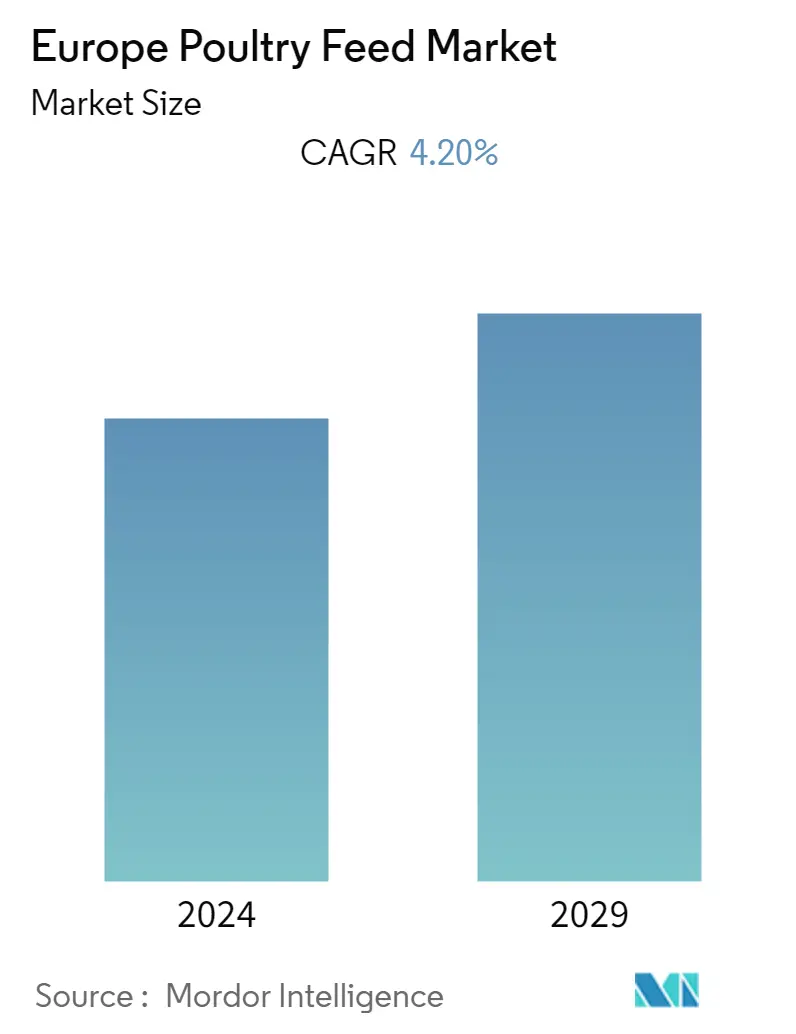
| Study Period | 2019 - 2029 |
| Base Year For Estimation | 2023 |
| Forecast Data Period | 2024 - 2029 |
| Historical Data Period | 2019 - 2022 |
| CAGR | 4.20 % |
| Market Concentration | Low |
Major Players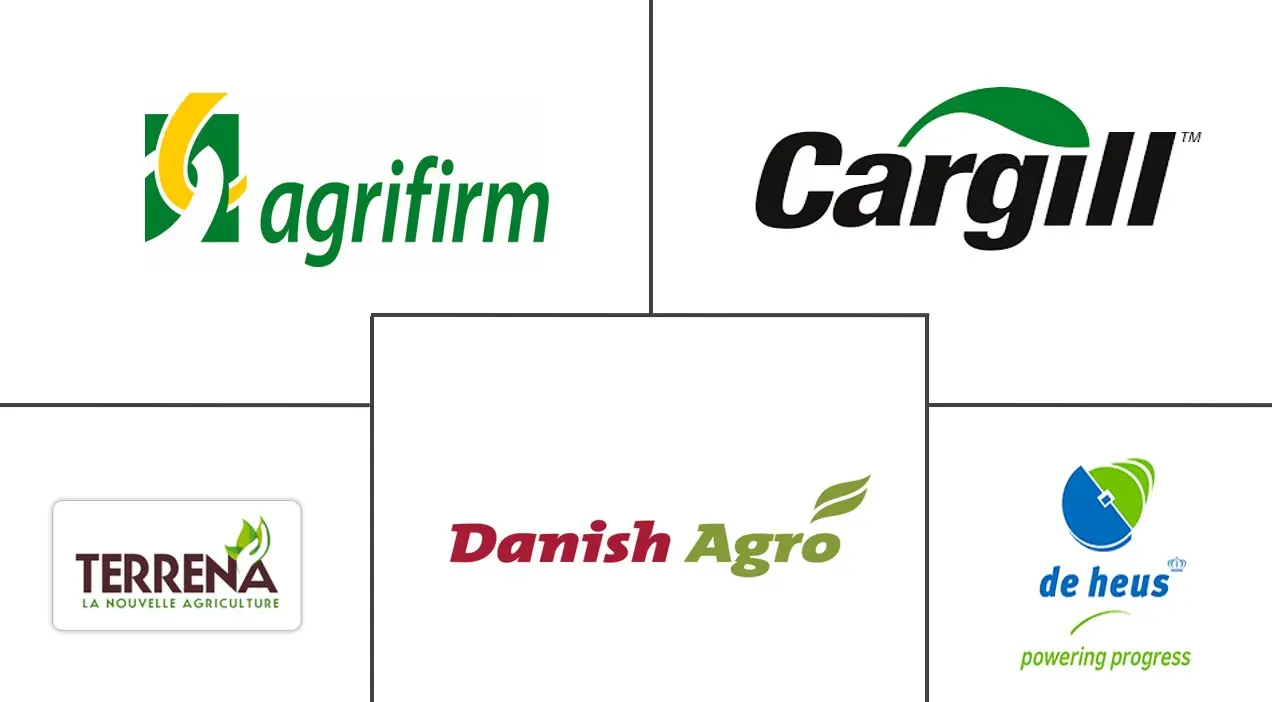
*Disclaimer: Major Players sorted in no particular order |
EU Poultry Feed Market Analysis
The European poultry feed market is projected to register a CAGR of 4.2% during the forecast period.
- Feed ingredients for poultry diets are selected for the nutrients they can provide, the absence of anti-nutritional or toxic factors, their palatability or effect on voluntary feed intake, and their cost. Currently, the demand for protein-rich feed is currently high in the EU, which will boost the market.
- The EU has lifted its ban on the use of animal by-products for animal feed which allows processed animal protein from pigs to be used in poultry feed and encourages the use of by-products from within the food industry, and also promotes the use of sustainable and local ingredients. The rules have to allow additional types of processed animal protein to be used in poultry and pig feed when they have been proven to be safe. The ban on the use of processed animal protein in feed for cows, sheep, and other ruminants, and on intra-species recycling, remains in force.
- According to the European Feed Manufacturers Federation (FEFAC), in 2021, even though there was severe Avian influenza in several parts of Europe, poultry feed production increased slightly by 0.8% because of HORECA chain (Hotel/Restaurant/ Catering) reopened after uplifting of lockdown.
- The major factors driving the market are the relatively low and competitive pricing of poultry meat compared to other meat, the absence of cultural or religious obstacles and dietary and nutritional (protein) qualities are the main factors of attraction driving the market growth. With the rising health crisis, consumers' attention has been mainly focused on production methods and the reliability of the information. The growing poultry production led to increased feed production in the region.
EU Poultry Feed Market Trends
Growing Meat Production Drives the Market
Due to the rising meat consumption, producers are also shifting production trends to meet consumer demand. The European Union is one of the world's largest poultry meat producers and a net exporter of poultry products with an annual production of around 13.4 million tons and imports high-value poultry products, including breast meat and poultry preparations, mainly from Brazil, Thailand, and Ukraine.
As consumption in hotels, restaurants, and institutional (HRI) outlets resumes, demand for inexpensive chicken meat, especially from Brazil and Thailand, is rising. EU chicken meat imports now also benefit from the EU decision to temporarily suspend import quotas and tariffs on Ukrainian products. Within the EU, increasing food inflation and higher energy costs will continue to favor chicken meat consumption as other animal proteins remain relatively more expensive.
According to FAO, the production of poultry meat increased in Poland with 2.5 million metric tons last year, followed by France and Germany. The meat production in the region is projected to grow further during the forecast period, which will drive poultry feed production.
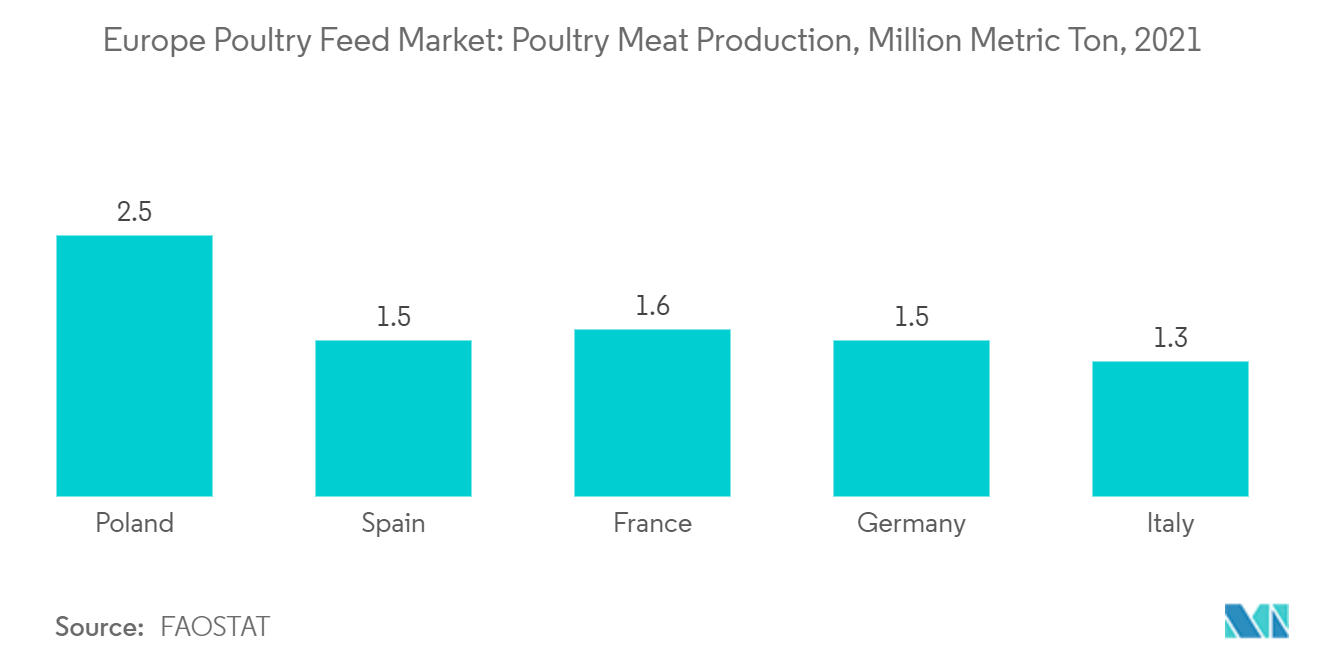
The Cereals Segment Dominates the Market
Cereal grains are used mainly to satisfy the energy requirement of poultry. The dominant feed grain is corn, although different grains are used in various countries and regions of the world. For instance, in the US, Brazil and most Asian countries corn is by far the most important energy source for all poultry feed, whereas wheat is the predominant supplier of dietary energy for poultry diets in Europe, Canada, Australia, New Zealand, and the Russian Federation. In addition to the cereals themselves, their by-products, such as wheat bran, rice bran, and DDGS, are used widely in poultry feed.
Ukraine produces on average 26 million ton of wheat per year, most of which is exported. The FAO estimates that, due to the war, cereal production in Ukraine is likely to be reduced by between 20% and 30%. A more extreme scenario of a 50% reduction in Ukrainian wheat production which a deficit of 13 million ton of wheat and many lower-income countries outside the EU rely on food, is expected to be severely reduced due to the war. The main impacts of the war on EU farmers are a limited reduction in animal feed imports and a disruption in the supply chains of synthetic fertilizers, the majority of which is used to grow animal feed for industrial meat production.
According to FAOSTAT, Europe also imported cereals amounting to 90.6 million metric ton in 2021 compared to 93.8 million metric ton in 2020 which is slightly declined due to impact of pandemic in the region. Hence, the growing poultry population coupled with intensive production trends will further drive the growth of the segment during the forecast period.
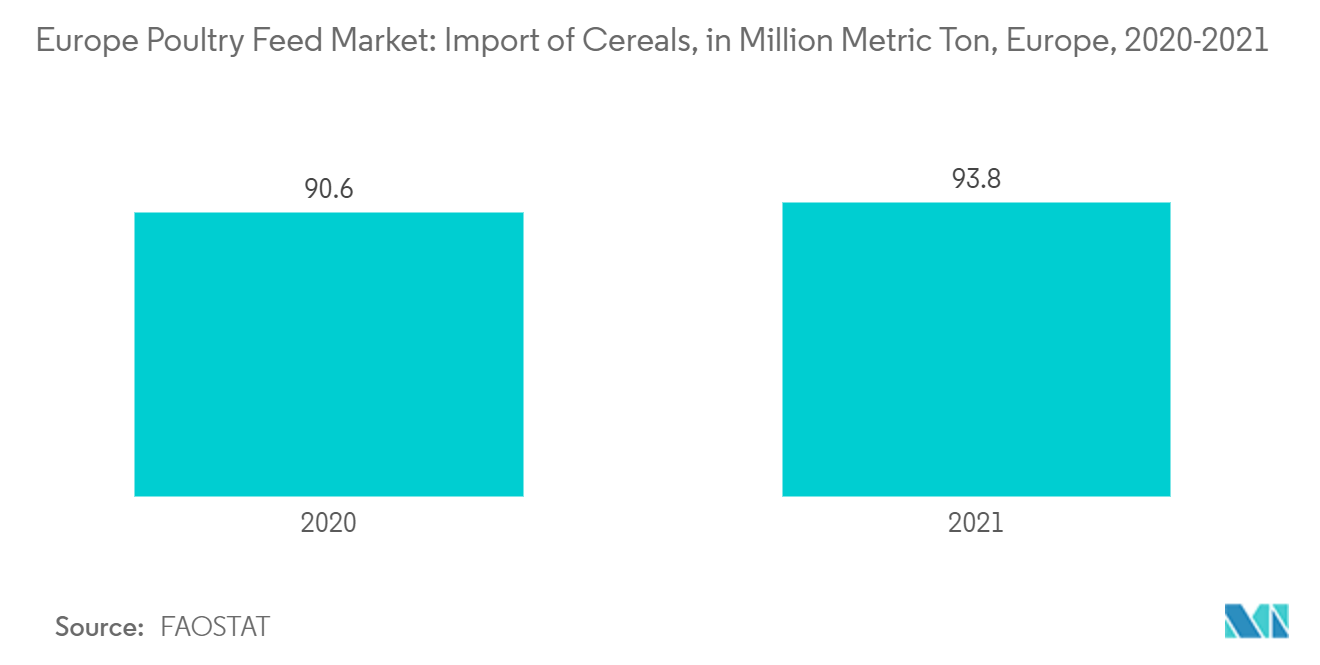
EU Poultry Feed Industry Overview
The European poultry feed market is fragmented, with the presence of various participants across several regions. The market studied displays unique characteristics, such as very few large manufacturing companies and a highly unorganized market with several regional players with small market shares. The leading companies are focused on acquiring feed mills and small manufacturing facilities to expand their businesses in the domestic and international markets. Terrena, Royal Agrifirm Group, Cargill Incorporated, De Hues, and Danish Agro are among the leading players in the market.
EU Poultry Feed Market Leaders
-
Terrena
-
Royal Agrifirm Group
-
Cargill, Incorporated.
-
De Hues
-
Danish Agro
*Disclaimer: Major Players sorted in no particular order
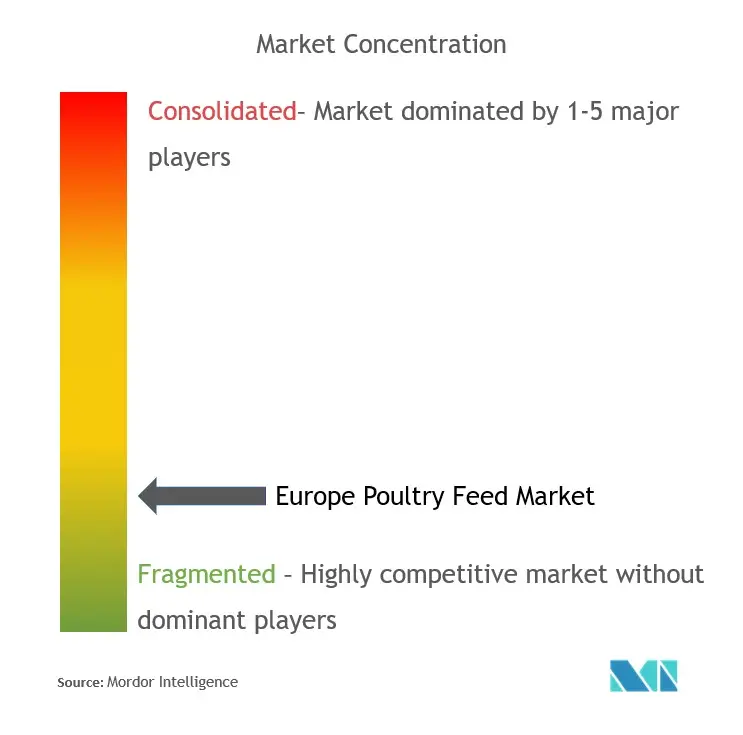
EU Poultry Feed Market News
- Sept 2022: Cargill introduced a new mini-pellet chick feed to promote chick start in the first 120 hours of a bird's life, which includes precise amounts of protein, starch, fat, and additives in highly digestible ingredients to promote maximum nutrient digestibility.
- Jan 2022: EU banned the routine use of antibiotics in farmed animals as most of these animals suffer in factory farms where they are dosed with antibiotics in their feed or water to prevent them from succumbing to disease because of cruel treatment. The overuse of antibiotics is resulting in a global public health crisis, with as many as 3,500 human deaths worldwide from antimicrobial-resistant infections. It is now illegal to use antibiotics to compensate for low welfare practices.
- Mar 2021: De Heus acquired Polish compound feed company Golpasz, a leading broiler feed manufacturer in Poland. This acquisition will strengthen De Heus to be in a leading position in Poland.
EU Poultry Feed Market Report - Table of Contents
1. INTRODUCTION
- 1.1 Study Assumptions and Market Definition
- 1.2 Scope of the Study
2. RESEARCH METHODOLOGY
3. EXECUTIVE SUMMARY
4. MARKET DYNAMICS
- 4.1 Market Overview
- 4.2 Market Drivers
- 4.3 Market Restraints
-
4.4 Porter's Five Force Analysis
- 4.4.1 Bargaining Power of Suppliers
- 4.4.2 Bargaining Power of Buyers
- 4.4.3 Threat of New Entrants
- 4.4.4 Threat of Substitute Products
- 4.4.5 Intensity of Competitive Rivalry
5. MARKET SEGMENTATION
-
5.1 Animal Type
- 5.1.1 Layer
- 5.1.2 Broiler
- 5.1.3 Turkey
- 5.1.4 Other Animal Types
-
5.2 Ingredient
- 5.2.1 Cereals
- 5.2.2 Oilseed Meals
- 5.2.3 Molasses
- 5.2.4 Fish Oils and Fish Meals
- 5.2.5 Supplements
- 5.2.6 Other Ingredients
-
5.3 Geography
- 5.3.1 United Kingdom
- 5.3.2 Spain
- 5.3.3 Italy
- 5.3.4 Germany
- 5.3.5 France
- 5.3.6 Russia
- 5.3.7 Rest of Europe
6. COMPETITIVE LANDSCAPE
- 6.1 Most Adopted Strategies
- 6.2 Market Share Analysis
-
6.3 Company Profiles
- 6.3.1 Alltech Inc.
- 6.3.2 BASF SE
- 6.3.3 Nutreco NV
- 6.3.4 Cargill Inc.
- 6.3.5 Terrena
- 6.3.6 Danish Agro
- 6.3.7 Royal Agrifirm Group
- 6.3.8 De Hues
- 6.3.9 Roquette Freres SA
- *List Not Exhaustive
7. MARKET OPPORTUNITIES AND FUTURE TRENDS
** Subject To AvailablityEU Poultry Feed Industry Segmentation
Poultry feed is food for farm poultry, including chickens, ducks, geese and other domestic birds. It contains all of the nutrients for the best growth of the flock or egg production.
The European Poultry Feed Market is Segmented by Animal Type (Layer, Broiler, Turkey, and Other Animal Types), Ingredients (Cereal, Oilseed Meal, Molasses, Fish Oil and Fish Meal, Supplements, and Other Ingredients), Supplement (Vitamins, Amino Acids, Antibiotics, Enzymes, Anti-Oxidants, Acidifiers, Probiotics and Prebiotics, and Other Supplements), and Geography (United Kingdom, Germany, Italy, France, Spain, Russia, and Rest of Europe). The report offers market sizing and forecasts in terms of value (USD million) for all the above segments.
| Animal Type | Layer |
| Broiler | |
| Turkey | |
| Other Animal Types | |
| Ingredient | Cereals |
| Oilseed Meals | |
| Molasses | |
| Fish Oils and Fish Meals | |
| Supplements | |
| Other Ingredients | |
| Geography | United Kingdom |
| Spain | |
| Italy | |
| Germany | |
| France | |
| Russia | |
| Rest of Europe |
EU Poultry Feed Market Research FAQs
What is the current Europe Poultry Feed Market size?
The Europe Poultry Feed Market is projected to register a CAGR of 4.20% during the forecast period (2024-2029)
Who are the key players in Europe Poultry Feed Market?
Terrena, Royal Agrifirm Group, Cargill, Incorporated., De Hues and Danish Agro are the major companies operating in the Europe Poultry Feed Market.
What years does this Europe Poultry Feed Market cover?
The report covers the Europe Poultry Feed Market historical market size for years: 2019, 2020, 2021, 2022 and 2023. The report also forecasts the Europe Poultry Feed Market size for years: 2024, 2025, 2026, 2027, 2028 and 2029.
EU Poultry Feed Industry Report
Statistics for the 2024 EU Poultry Feed market share, size and revenue growth rate, created by Mordor Intelligence™ Industry Reports. EU Poultry Feed analysis includes a market forecast outlook 2029 and historical overview. Get a sample of this industry analysis as a free report PDF download.



